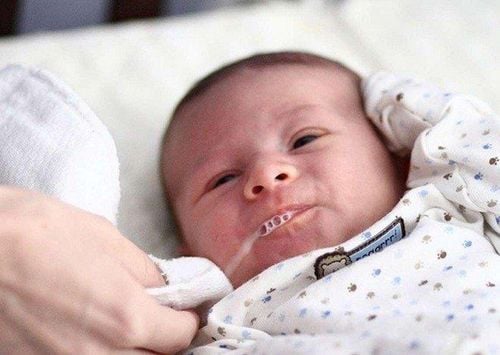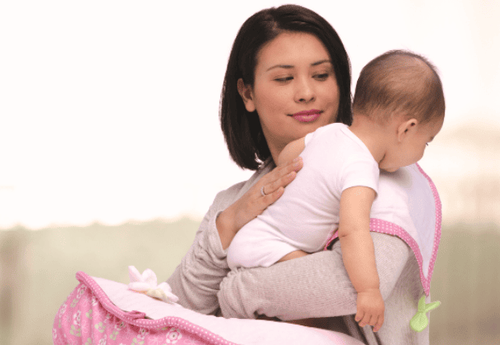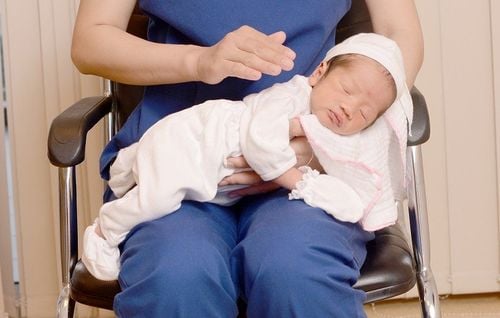This is an automatically translated article.
The article was written by Resident Doctor Duong Van Sy - Pediatric Resident, Department of Pediatrics - Neonatology - Vinmec Hai Phong International General Hospital.Laryngeal flaccidity is a congenital abnormality of laryngeal cartilage used to describe cases where the tissue supporting the anatomical structures above the larynx, including the epiglottis and the funnel cartilage, has not developed in time, causing these structures to prolapse into the airways. The baby's breathing makes a wheezing sound.
1. Laryngeal soft cartilage is what disease?
Laryngeal softening is the most common congenital defect in the glottis and larynx, accounting for about 60% of congenital laryngeal abnormalities. The disease causes clinical stridor, twice as many boys as girls.The phenomenon of soft cartilage of the larynx mainly occurs in the epiglottis of the larynx, the cartilage of the funnel, or in both of the above structures. Laryngeal flaccid disease is rare, accounting for only 0.01% of ENT diseases in general.
2. Symptoms of soft cartilage in the larynx
Wheezing Children with laryngeal softening are usually discovered at 4-6 weeks of age because of the onset of wheezing, sometimes as early as or as late as 2 months (in children under this age the airflow is not strong enough to blow out). wheezing sound). Intermittent wheezing on inhalation. The wheezing sound at first is easily mistaken for a blocked nose, but it is long-lasting and there is no mucus in the child's nose. The timbre of a child's wheezing can be as high as a hiss. Wheezing increases when the child is placed on his or her back, when the child is irritable and fussy, or when there is an associated upper respiratory tract infection. Many cases of wheezing during and after feeding. (when the child is placed in the supine position, under the action of gravity, the epiglottis will protrude into the airway more and make the child wheeze more.) + Except when there is combined laryngitis, in general the child still plays. and suckle as usual. Gastroesophageal reflux disease Up to 80-100% of children with MS also have gastroesophageal reflux disease: due to partial obstruction of the inner glottis during inspiration, and when the child tries to inhale, it will increase the negative pressure in the chest. Too much food in the stomach in the baby's abdomen is easy to back up into the esophagus (the part of the digestive tract located in the chest).In contrast, children with severe gastroesophageal reflux disease will have pathological structural changes similar to laryngeal softening, especially swelling and bulging of the funnel cartilage.
Other symptoms may be present

Ọc sữa là một trong số những triệu chứng kèm theo khi trẻ bị mềm sụn thanh quản
Subclinical Laryngoscopy with flexible bronchoscope to determine whether the child has soft laryngeal cartilage or not. Chest X-ray: Assess for abnormalities such as tracheal flaccidity, vascular rings.. Many children with laryngeal flaccidity may have other causes of wheezing. X-rays can screen for other potential causes of wheezing in the upper airway, trachea, chest, and lungs. Thoracic and abdominal SA: evaluate RGO (usually used in clinical practice) There is a strong relationship between laryngeal softening and gastroesophageal reflux. All babies can hiccup and regurgitate milk, but children with laryngospasm are more likely to regurgitate milk than other children. Acid reflux from the stomach into the esophagus and larynx can cause additional inflammation of tissues already affected by softening of the larynx.
3. Level classification
3.1 Mild Inspiratory wheezing was uncomplicated with severe airway obstruction, did not affect the nursing infant, and had no other associated symptoms.These babies often fuss with their nanny but have no other health problems and usually clear up on their own after 12-18 months of age. If the child has mild laryngeal softening, it is still very important to pay attention to monitor the signs and symptoms of bad progress to promptly bring the child to a medical facility.
3.2 Moderate Infants are classified in this category when the following symptoms are present:
Wheezing on inhalation Vomiting of milk Airway obstruction (due to soft larynx) Difficulty feeding but does not affect the child's steady weight gain History Repeated hospitalization for airway obstruction Gastro-oesophageal reflux (vomiting of acid in the stomach) These children resolve spontaneously by 12-18 months of age but may require treatment for GERD. - Stomach. Even if the child is classified as a moderate disease, it is still very important to pay attention to monitor the signs and symptoms of worsening in order to promptly bring the child to a medical facility. 3.3 Severe Children in this category often may need surgery to correct. Doctors will recommend surgery if your child has any of the following symptoms:
Life-threatening shortness of breath Severe cyanotic episodes Severe chest and neck contractions when breathing Needs oxygen prolonged lack of oxygen Unable to gain weight because of difficulty in suckling

Trong trường hợp bé phải thở oxy, bác sĩ sẽ đề nghị phẫu thuật.
4. Diagnosis
Clinical and laryngoscopy5. Risk factors for laryngeal softening
Premature babies Neuromuscular diseases Associated respiratory tract injuries: tracheal fibrillation, subglottic stenosis...6. Treatment & care
6.1 Medical More than 99% will gradually resolve without treatment, most will stop wheezing by 2 years of age. Wheezing will increase during the first 6 months after birth because the amount of air the baby breathes increases with age. After that age, the wheezing does not increase anymore and gradually decreases and then disappears. In many cases, the symptoms disappear, but the pathologic features persist into adulthood and the child may return wheezing with exertion or occasionally with respiratory viral infections. Hospitalization: Not necessary unless the child shows signs of hypoxia or apnea. If blood oxygen saturation is higher than 90%, then no need to breathe oxygen There is no specific treatment, can add vitamin D and calcium. Usually treated when there is gastroesophageal reflux (according to the protocol) and associated respiratory infections When the child is severely hypoxic and needs to be hospitalized to measure the blood oxygen level. If the resting blood oxygen level is <90%, the child will be given oxygen. If the baby can still suckle, play, gain weight normally, and only have wheezing in the first 2 months after birth, no further treatment is needed. Laryngitis is a common diagnosis and the doctor will reassure the child's parents about the nature of this condition. Outpatient treatment: No need to give the child any other medicine. Re-examination as prescribed by the doctor, if any Still vaccinating the child as normal as other children 6.2 Surgery For severe cases of laryngospasm causing difficulty in suckling, poor weight gain and development, surgery can be used. art.Surgery simply involves shaping the supporting structures around the epiglottis, removing excess tissue that obstructs the airways. Very rarely, surgery is required to treat softening of the laryngeal cartilage. If the child has had surgery, it is still advisable to continue to treat gastroesophageal reflux disease and parents still need to watch for signs of bad changes to promptly take the child to a medical facility. 6.3 Care

Nên để trẻ sơ sinh nằm nghiêng, thỉnh thoảng trở mình cho bé đỡ mỏi
Customers can directly go to Vinmec Health system nationwide to visit or contact the hotline here for support.
SEE ALSO:
How to properly wash your baby's nose Learn about soft laryngeal cartilage What to do when a child has soft larynx?














